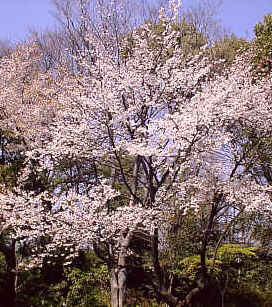
Plant Description
Caution & Interaction

Latin (botanical) name:
Prunus serotina
Common names: Wild Cherry, Virginian Prune, Black Cherry, Black Choke, Choke Cherry, Rum Cherry
Plant Description: Prunus, the Wild Cherry, is a large tree, 50-80 feet tall, and 2-4 feet in diameter. It is widely distributed in woods throughout North America, especially in the Northern and Central states. Wild Cherry grows from Nova Scotia and New Brunswick west to Southern Quebec and Ontario into Michigan and eastern Minnesota; south to Iowa, extreme eastern Nebraska, Oklahoma, and Texas, then east to central Florida.The bark is rough and black on older trunks, and separates naturally from the tree trunk. The bark that is used medicinally is younger, smooth, glossy and reddish brown. The fruit is a nearly spherical, purple-black drupe, around 1.5cm in diameter, ripening in late summer and autumn. Wild Cherry produces deciduous, alternate, oblong or ovate leaves with serrated margins. The upper surface of the leaves is glossy and somewhat thick. The Wild Cherry blossoms in May with white flowers in erect terminal racemes; an occasional solitary flower will bloom in the axils of the leaves. Around August or September, the fruit of the Wild Cherry ripens. It is about the size of a pea, black or tinged with purple, globular drupe that is edible, but with a bitter taste.
Medicinal Properties &Uses: The constituents of Wild Cherry include cyanogenic glycosides including prunasin, volatile oil, benzaldehyde, coumarins, resin, tannin, benzoic acid, gallic acid, resin, the enzyme prunase, and starch. The cyanogenic glycosides make Wild Cherry a powerful cough remedy. Prussic acid sedates the sensory nerves which provoke the cough reflex. Because of its sedative properties, it is an effective treatment for bronchitis, whooping cough, and racking coughs from cold as it loosens phlegm in the throat and the chest. The glycosides and volatile oil contained within Wild Cherry Bark also serve to improve digestion. An infusion of the bark has been used as an astringent in diarrhea or an eyewash when the eyes become inflamed. Wild Cherry may also be helpful against cancer. In 1999, Michigan State University scientists realized that the dark coloring material of wild cherries is a source of anthocyanins. The antioxidant activity in cherries is even greater than that of vitamin E. Wild cherries also contain pain-relieving compounds and a surprisingly high level of melatonin, a hormone previously believed only to be produced by the brain. As Wild Cherry may have anticancer properties, more research is being done at Johns Hopkins University to study the use of cherries in alleviating the pain of cancer.
Dosage: 30-60 drops in water or juice, 2-3 times daily or as needed. Shake well before using.
Cautions & Interactions: Keep out of reach of children.
Efficacy Studies & Other Clinical Data: Helpful Links:
Disclaimer (U.S. Only): These statements have not been evaluated by the FDA. These products are not intended to diagnose, cure, treat, or prevent any disease.
Common names: Wild Cherry, Virginian Prune, Black Cherry, Black Choke, Choke Cherry, Rum Cherry
Plant Description: Prunus, the Wild Cherry, is a large tree, 50-80 feet tall, and 2-4 feet in diameter. It is widely distributed in woods throughout North America, especially in the Northern and Central states. Wild Cherry grows from Nova Scotia and New Brunswick west to Southern Quebec and Ontario into Michigan and eastern Minnesota; south to Iowa, extreme eastern Nebraska, Oklahoma, and Texas, then east to central Florida.The bark is rough and black on older trunks, and separates naturally from the tree trunk. The bark that is used medicinally is younger, smooth, glossy and reddish brown. The fruit is a nearly spherical, purple-black drupe, around 1.5cm in diameter, ripening in late summer and autumn. Wild Cherry produces deciduous, alternate, oblong or ovate leaves with serrated margins. The upper surface of the leaves is glossy and somewhat thick. The Wild Cherry blossoms in May with white flowers in erect terminal racemes; an occasional solitary flower will bloom in the axils of the leaves. Around August or September, the fruit of the Wild Cherry ripens. It is about the size of a pea, black or tinged with purple, globular drupe that is edible, but with a bitter taste.
Medicinal Properties &Uses: The constituents of Wild Cherry include cyanogenic glycosides including prunasin, volatile oil, benzaldehyde, coumarins, resin, tannin, benzoic acid, gallic acid, resin, the enzyme prunase, and starch. The cyanogenic glycosides make Wild Cherry a powerful cough remedy. Prussic acid sedates the sensory nerves which provoke the cough reflex. Because of its sedative properties, it is an effective treatment for bronchitis, whooping cough, and racking coughs from cold as it loosens phlegm in the throat and the chest. The glycosides and volatile oil contained within Wild Cherry Bark also serve to improve digestion. An infusion of the bark has been used as an astringent in diarrhea or an eyewash when the eyes become inflamed. Wild Cherry may also be helpful against cancer. In 1999, Michigan State University scientists realized that the dark coloring material of wild cherries is a source of anthocyanins. The antioxidant activity in cherries is even greater than that of vitamin E. Wild cherries also contain pain-relieving compounds and a surprisingly high level of melatonin, a hormone previously believed only to be produced by the brain. As Wild Cherry may have anticancer properties, more research is being done at Johns Hopkins University to study the use of cherries in alleviating the pain of cancer.
Dosage: 30-60 drops in water or juice, 2-3 times daily or as needed. Shake well before using.
Cautions & Interactions: Keep out of reach of children.
Efficacy Studies & Other Clinical Data: Helpful Links:
Disclaimer (U.S. Only): These statements have not been evaluated by the FDA. These products are not intended to diagnose, cure, treat, or prevent any disease.